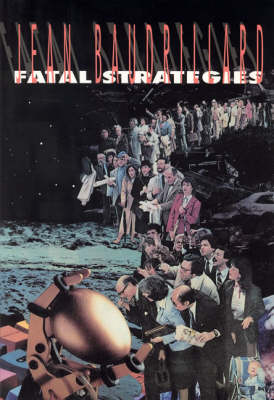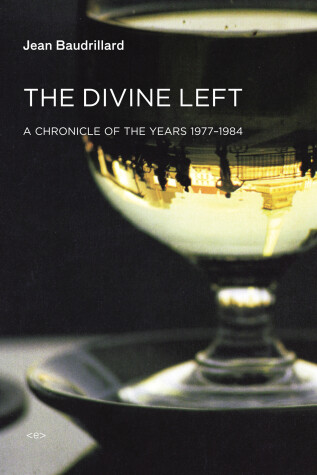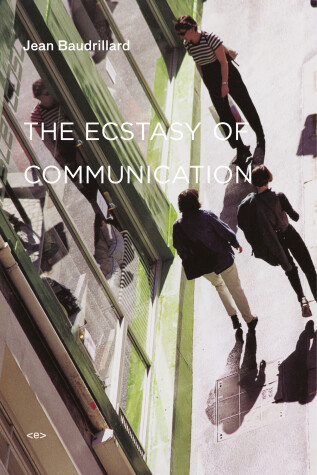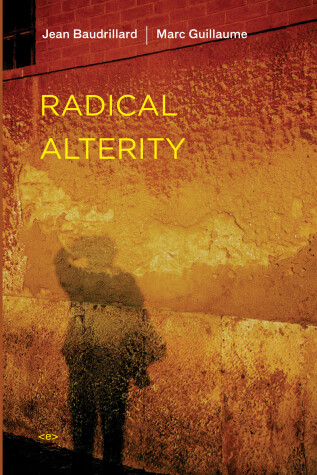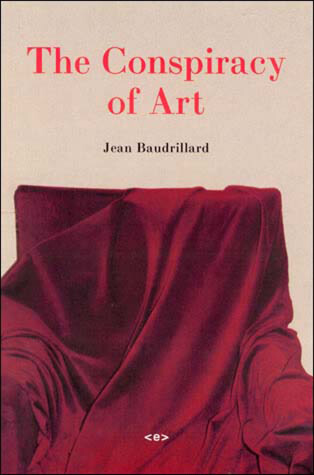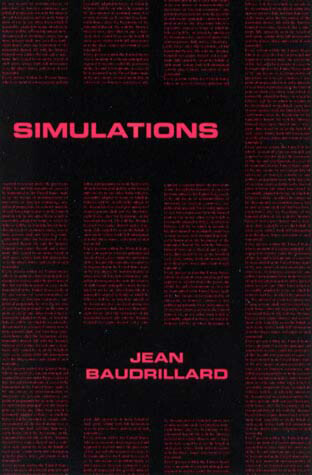Semiotext(e) / Foreign Agents
9 total works
First published in French in 1985, The Divine Left is Jean Baudrillard's chronicle of French political life from 1977 to 1984. It offers the closest thing to political analysis to be found from a thinker who has too often been regarded as apolitical. Gathering texts that originally appeared as newspaper commentary on François Mitterand's rise to power as France's first Socialist president and the Socialist Party's fraught alliance with the French Communist Party, The Divine Left in essence presents Baudrillard's theory of the simulacrum as it operates in the political sphere.
In France, the Left, and even the ultra-Left, had been seduced by power. This scenario—dissected by Baudrillard with deadpan humor and an almost chilling nonchalance—produced a Socialist Party that devoted itself to rallying the market economy and introducing neoliberalism, and replaced an intellectual class with the media stars and hyper-professionals of the spectacle. Starting from the elections of 1977, Baudrillard analyzes—in “real time,” as it were—how the Left's taking of power had in fact been an enaction of not just its own death throes, but those of power itself. The Divine Left outlines a simulation of politics that offers discomfiting parallels to our political world today, a trajectory that has only grown more apparent in recent years: the desire and intention to fail.
“The need to speak, even if one has nothing to say, becomes more pressing when one has nothing to say, just as the will to live becomes more urgent when life has lost its meaning.”
—from The Ecstasy of Communication
First published in France in 1987, The Ecstasy of Communication was Baudrillard's summarization of his work for a postdoctoral degree at the Sorbonne: a dense, poetically crystalline essay that boiled down two decades of radical, provocative theory into an aphoristically eloquent swan song to twentieth-century alienation. Baudrillard's quixotic effort to be recognized by the French intellectual establishment may have been doomed to failure, but this text immediately became a pinnacle to his work, a mid-career assessment that looked both forward and back. By carefully distilling the most radical elements of his previous books, Baudrillard constructed the skeleton key to all of the work that was to come in the second half of his career, and set the scene for what he termed the “obscene”: a world in which alienation has been succeeded by ceaseless communication and information. The Ecstasy of Communication is a decisive, compact description of what it means to be “wired” in our braver-than-brave new world, where sexuality has been superseded by pornography, knowledge by information, hysteria by schizophrenia, subject by object, and violence by terror.
The Ecstasy of Communication is an anti-manifesto that confronted and dispensed with such influences as Marshall McLuhan, Guy Debord, and Georges Bataille. It is an essential crib-book, lexicon, and companion piece to any and all of Baudrillard's books. Twenty-five years after its original publication, it remains not only a prescient portrait of our contemporary condition, but also a dark mirror into which we have not yet dared to look.
In 1976, Jean Baudrillard sent this essay to the French magazine Critique, where Michel Foucault was an editor. Foucault was asked to reply, but remained silent. Forget Foucault (1977) made Baudrillard instantly infamous in France. It was a devastating revisitation of Foucault's recent History of Sexuality—and of his entire oeuvre—and also an attack on those philosophers, like Gilles Deleuze and Félix Guattari, who believed that desire could be revolutionary. In Baudrillard's eyes, desire and power were interchangeable, so desire had no place in Foucault's work. There is no better introduction to Baudrillard's polemical approach to culture than these pages, in which Baudrillard dares Foucault to meet the challenge of his own thought. This Semiotext(e) edition of Forget Foucault is accompanied by a dialogue with Sylvère Lotringer, "Forget Baudrillard," a reevaluation by Baudrillard of his lesser-known early works as a post-Marxian thinker. Lotringer presses Baudrillard to explain how he arrived at his infamous extrapolationist theories from his roots in the nineteenth and early twentieth century social and anthropological works of Karl Marx, Marcel Mauss, and Emil Durkheim.
The Utopie group was born in 1966 at Henri Lefebvre's house in the Pyrenees. The eponymous journal edited by Hubert Tonka brought together sociologists Jean Baudrillard, René Lourau, and Catherine Cot, architects Jean Aubert, Jean-Paul Jungmann, Antoine Stinco, and landscape architect Isabelle Auricoste. Over the next decade, both in theory and in practice, the group articulated a radical ultra-leftist critique of architecture, urbanism, and everyday life. Utopia Deferred collects all of the essays Jean Baudrillard published in Utopie as well as recent interviews with Jean Baudrillard and Hubert Tonka.Utopie served as a workshop for Baudrillard's thought. Many of the essays he first published in Utopie were seminal for some of his most shockingly original books: For a Critique of the Political Economy of the Sign, The Mirror of Production, Simulations, Symbolic Exchange and Death, and In the Shadow of the Silent Majorities. But Utopie was also a topical journal and a political one; the topics of these essays are often torn from the headlines of the tumultuous decade following the uprisings of May 1968.
Alterity is in danger. It is a masterpiece in peril, an object lost or missing from our system, from the system of artificial intelligence and the system of communication in general.—from Radical Alterity
Where is the Other today? Can Otherness challenge our arrogant, insular cultural narcissism? From artificial intelligence to the streets of Venice, from early explorers to contemporary photographers, Jean Baudrillard and Marc Guillaume discuss the traces of radical alterity in our world. These provocative seminars, held in 1990 and 1991, follow the multiple, intertwined trajectories first projected in Baudrillard's work and his reading of the “radical exoticism” posited by Victor Segalen—ideas Baudrillard extends into the realms of mass media, pseudonyms, technology, and that illusorily close yet radically foreign “primitive society of the future,” America. In a world where no corner is unexplored, the Other remains a challenge to thought, a crack in the shell of universal understanding, impossible to communicate but potentially the linchpin of communication itself. Together, Baudrillard and Guillaume explore the threatened and fatal figures of radical alterity. This collection is no longer available in French, and this English edition includes an additional essay by Baudrillard, “Because Illusion and Reality Are Not Opposed.”
The images from Abu Ghraib are as murderous for America as those of the World Trade Center in flames. The whole West is contained in the burst of sadistic laughter of the American soldiers, as it is behind the construction of the Israeli wall. This is where the truth of these images lies. Truth, but not veracity. As virtual as the war itself, their specific violence adds to the specific violence of the war. In The Conspiracy of Art, Baudrillard questions the privilege attached to art by its practitioners. Art has lost all desire for illusion: feeding back endlessly into itself, it has turned its own vanishment into an art unto itself. Far from lamenting the "end of art," Baudrillard celebrates art's new function within the process of insider-trading. Spiraling from aesthetic nullity to commercial frenzy, art has become transaesthetic, like society as a whole. Conceived and edited by life-long Baudrillard collaborator Sylvère Lotringer, The Conspiracy of Art presents Baudrillard's writings on art in a complicitous dance with politics, economics, and media. Culminating with "War Porn," a scathing analysis of the spectacular images from Abu Ghraib prison as a new genre of reality TV, the book folds back on itself to question the very nature of radical thought.
Baudrillard's bewildering thesis, a bold extrapolation on Ferdinand de Saussure's general theory of general linguistics, is in fact a clinical vision of contemporary consumer societies where signs don't refer anymore to anything except themselves. They all are generated by the matrix.
Simulations never existed as a book before it was "translated" into English. Actually it came from two different bookCovers written at different times by Jean Baudrillard. The first part of Simulations, and most provocative because it made a fiction of theory, was "The Procession of Simulacra." It had first been published in Simulacre et Simulations (1981). The second part, written much earlier and in a more academic mode, came from L'Echange Symbolique et la Mort (1977). It was a half-earnest, half-parodical attempt to "historicize" his own conceit by providing it with some kind of genealogy of the three orders of appearance: the Counterfeit attached to the classical period; Production for the industrial era; and Simulation, controlled by the code. It was Baudrillard's version of Foucault's Order of Things and his ironical commentary of the history of truth. The book opens on a quote from Ecclesiastes asserting flatly that "the simulacrum is true." It was certainly true in Baudrillard's book, but otherwise apocryphal.One of the most influential essays of the 20th century, Simulations was put together in 1983 in order to be published as the first little black book of Semiotext(e)'s new Foreign Agents Series. Baudrillard's bewildering thesis, a bold extrapolation on Ferdinand de Saussure's general theory of general linguistics, was in fact a clinical vision of contemporary consumer societies where signs don't refer anymore to anything except themselves. They all are generated by the matrix.In effect Baudrillard's essay (it quickly became a must to read both in the art world and in academe) was upholding the only reality there was in a world that keeps hiding the fact that it has none. Simulacrum is its own pure simulacrum and the simulacrum is true. In his celebrated analysis of Disneyland, Baudrillard demonstrates that its childish imaginary is neither true nor false, it is there to make us believe that the rest of America is real, when in fact America is a Disneyland. It is of the order of the hyper-real and of simulation. Few people at the time realized that Baudrillard's simulacrum itself wasn't a thing, but a "deterrence machine," just like Disneyland, meant to reveal the fact that the real is no longer real and illusion no longer possible. But the more impossible the illusion of reality becomes, the more impossible it is to separate true from false and the real from its artificial resurrection, the more panic-stricken the production of the real is.
